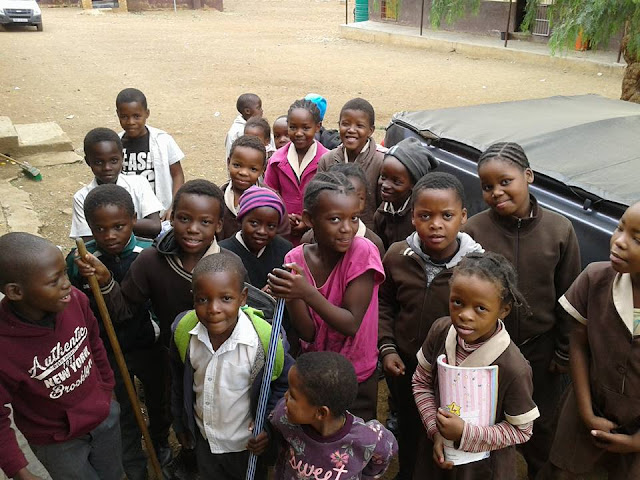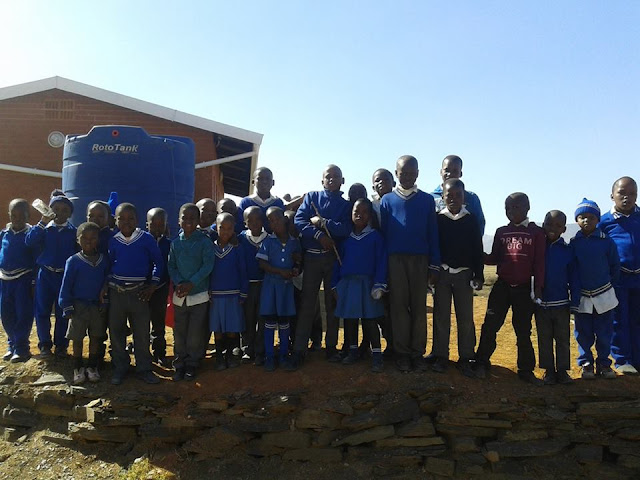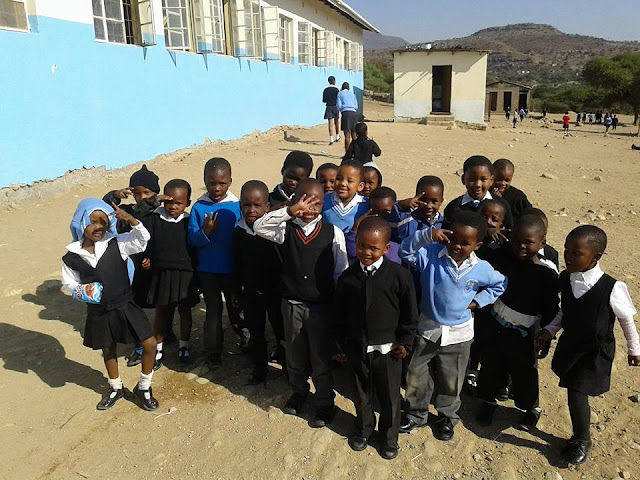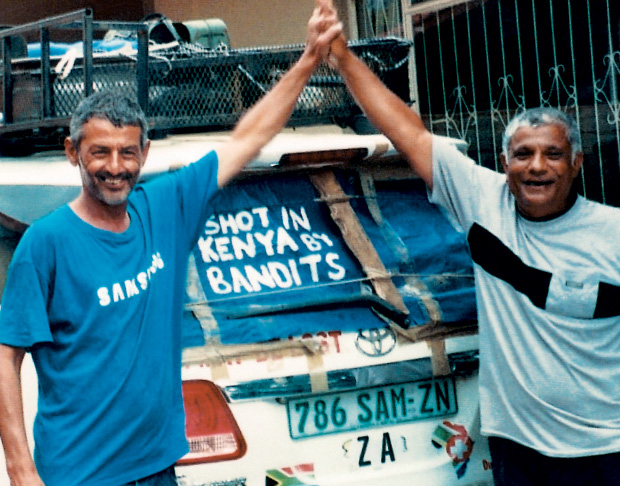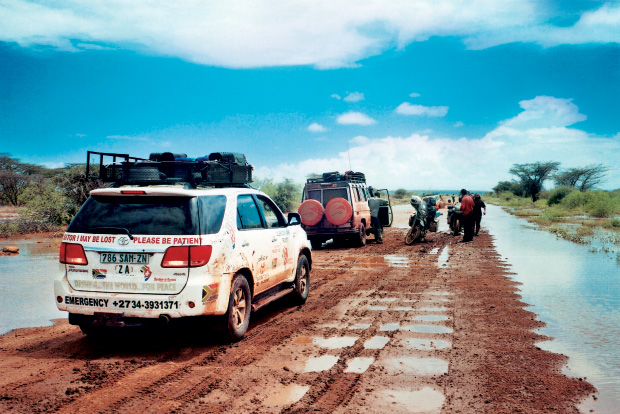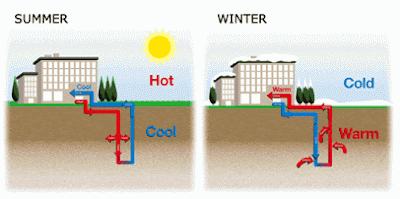GeoSolEarth is proud to be a part of rural skills development and job creation in South Africa. Most of the areas we service are poor with high unemployment rates. The roads we travel on are gravel dirt roads and the areas lack electricity, sanitation and clean drinking water.
We are however very fortunate to still see smiles on the faces of local kids and people... Our Geotechnical Solutions staff are always blown away by the warm welcomes and happy faces.
Emkhuphula Learners always had the most interesting stories...
Skills Development and Job Creation in Emmaus... Empowering the Community within the Building and Construction Sectors...
There is also a lack of classrooms and no maths or science teachers...
GeoSolEarth Videos... GeoSolEarth Videos
Next - Ranching and Ownership Responsibilities
South Africa to India by Car.
Adventurer - Traveler - A Sunday drive between 2 friends in a Toyota Fortuner that started from:
South Africa - Mozambique - Malawi - Tanzania - Zanzibar - Kenya - Ethiopia - Sudan - Sinai - Egypt - Under the Suez - Jordan - Syria - Turkey - Georgia - Azerbaijan - Armenia - Iran - Pakistan -India - Nepal - Dubai

...
And then back to South Africa.
All with minimum Visas. Facebook - Ayob Vawda
By Frans van der Merwe
Driving The World For Peace - an “impossible journey” which started off in July 2008 in KwaZulu-Natal is nearing its end after more than 75 000 km.
Two South African adventurers, Ayob Vawda and Abdool Samath, stopped over in Louis Trichardt this week on the homeward leg of a journey, which they were told beforehand that it would be “impossible.”
Their extraordinary trip, which brought them some incredible adventures, took them through the Eastern part of Africa, several hot spots in the Middle East - including Iran and Yemen - and right through to India. They were turned away from the border of China, even though their visas were in order.
They have high praise for South Africa’s diplomatic missions in the countries they visited.
“Everywhere we received a very special welcome,” said Abdool. The foreign media, including television stations, also celebrated the two South Africans’ extraordinary exploit.
Apart from some tight situations at some borders (in Georgia they had to fake a medical emergency to convince the authorities to allow them through) and a shot-out back window of their vehicle, which is evidence of an attack by bandits in Kenya, they are enthusiastic and cheerful about their multi-facetted encounters and amazing experiences.
In Louis Trichardt, where they stopped over for refreshments in Eltivillas, their odometer registered a completed journey of 75 340km.
A large colour photo of Madiba on the side of their vehicle, worked “magic” when they were held up by bandits in Kenya. When Abdool politely requested an aggressive bandit to point the gun away from his face, the change in direction brought the picture of Madiba in full view. The bandit’s aggression changed into jubilant admiration, and the two adventurers were allowed to journey on!
Soldiers of Fortuner
Images and Article : Toyota Zone
Almost 75000 km into the journey, there was a moment where it could have all gone terribly, horribly wrong. Ayob Vawda and Abdool Samath had been on the road for more than 20 months and, apart from a single puncture in Yemen, nothing had disrupted their wonderful odyssey that had begun far away in Cape Town, where anything seemed possible. “We were on our way back home, running through the mountainous region of Kenya, and were told that the road through was impassable because of heavy rains.
So we waited, and waited some more, and every day the rains came again, making the situation worse,” Ayob Vawda recalls from the comfort of his Ladysmith home, where he’s still trying to wrestle the wanderlust bug out of his system. “The roads were bad alright. Soft thick mud with great big grooves carved out by trucks – which is what happens in the rainy season – threatened to bog us down. “Every so often we came across abandoned vehicles that hadn’t made it, and the only thing to do was to keep momentum going, slowly, gently and to drive around the stricken cars and trucks if necessary. I’m no 4X4 expert but after nearly two years away from home driving in these conditions I’d developed a feel for it. So it was first and second gear in low range, for many kilometres at a time. “All of a sudden, a little kid appeared on the side of the road flagging us down. We naturally slowed, wondering what the problem was, and as we came to a stop I heard these strange, sharp popping sounds. It took me a second or so to realise it was gunfire. “It’s strange how time seems to tick so slowly in those moments. I remember seeing the child running away, remember his face and I thought he couldn’t have been part of this set-up because he looked so frightened, so surprised.
What I did was pure reaction. I just put my foot down and drove for my life. Our lives.” “The back window exploded from a shot, but all I could think of was to get away, and fortunately we got out of there. Later, when we got to the next town they said that the bandits in that area didn’t just take your car or your valuables, they took everything. They would strip you naked and leave you in that remote area to die.” Ayob and Abdool had dreamed of driving to China. They’d talked about it over and over again, but without making any real plans. Then Abdool bought a brand new Fortuner 3,0 D-4D 4×4 and convinced Ayob that the dream they’d talked about could actually become a reality. And so they set off – still without any plans, except to make it all the way to China. “We were both at loose ends, both single, our lives at a turning point. Abdool sold two of his properties and I sold my motor spares business on the South Coast, so we were self-funded. This was pure adventure.“After Abdool took delivery of the Fortuner from Dundee Toyota, we drove down from Glencoe, where he lives, to Cape Town.
We were totally unprepared; na?ve I think is the word. We had a roof rack only, fitted just before we left South Africa in Nelspruit to take water containers and two spare wheels, and for the rest we packed our stuff into those black plastic containers you buy at supermarkets.” Over the next 22 months and 80000 km, they journeyed from Cape Town through Mozambique and then into Malawi.From there the route traversed Tanzania, Kenya, Ethiopia, the Sudan, Egypt and then over the Suez Canal into Jordan, then Syria, Turkey and finally to the northern most point of their journey, Georgia, which was part of the former Soviet Union. “We had no schedule, which meant we could explore each country as we liked. This is how we logged such a huge distance on the Toyota. For instance, in Sudan we must have covered close to 15000 km, criss-crossing that vast country, which is about the size of South Africa. They then made an excursion East, travelling through Pakistan into India, and then to Nepal. It was here that Ayob was struck down with typhoid fever and hospitalised in Kathmandu. “This part of our trip was another attempt to find a route through to China, but for various reasons this didn’t happen, including falling foul of a no-right-hand-drive ruling in some countries. “It would take a book to describe all the wonderful experiences we had, and that is one of our plans. We saw fantastic sites, the tourist must-do places like the Taj Mahal which just takes your breath away, where up to 20000 people a day visit. “For me, one of the most unusual experiences was a trip through the desert in Egypt where almost no-one goes. We latched onto a tour run by Pan Arabic. They take visitors to World War II sites where you can see the remains of Italian, German and English planes still quietly rusting away in the desert. “We saw many more wonderful places – sufi temples, and the wonderful shrine in the middle of Mackinnon Road in Pakistan.
Here it is said that a saint called Sayyed Baghali Shah was working on a railway gang when the workers were threatened by a pride of lions. Baghali went out to confront the lions and befriended them, to the extent that they formed a protective laager around the railway gang so they could carry on with their work without fear of attack.” Later on when Baghali died and was buried the authorities tried to run the railroad through his grave, but each time they tried one of the workers died in mysterious circumstances. Thus the railway line that should have run straight at this point takes a mysterious kink, to circumnavigate Baghali’s burial site. “For our return trip we drove down pretty much the same way we’d come up Africa, except that we went through Zambia, not Mozambique. The roads are much better, but on the way up we had a duty to carry out for the Glencoe Relief Aid in Mozambique, gathering information that they would use to provide relief in the area against diseases such as TB and malaria. “When I set out I was an absolute novice in off-road driving, but after about 70000 km behind the wheel – Abdool did the rest – I felt like a master. We covered every hazard: soft sand, hard sand, rock, winding narrow tarmac, you name it. “The Fortuner was incredible. We had it serviced at major towns and cities every 10000 km, and I’m not kidding when I tell you that, apart from the one wheel we changed in Yemen, the Fortuner still has the original General tyres that came with the vehicle on delivery.
Quite amazing. It is still running its original brake pads too. The only breakages we had were three shock absorbers – and the rear window. “Despite sometimes travelling for days on end in low range, we didn’t have one spot of mechanical trouble!”Ayob and Abdool found that the closer they got to home after nearly two years away, the faster they wanted the journey to end. But it was with mixed feelings that they arrived home as, apart from all the wonderful sights and experiences, it was the hospitality and generosity of the people they met that will stay with them. Abdool, at the age of 66 is taking a break for a while, but Ayob, at 54, is already raring to go – again. Ayob’s Travelling Tips TZ: What advice would you give to readers embarking on a similar trip?AV: Go where your heart takes you, it’s all about the experience, not the distance.TZ: What would you do differently?AV: Nothing, everything was like a magical dream. The spiritual aspect of meeting so many people was wonderful. On a practical sense, the route via Zambia and Zimbabwe is better than via Mozambique where the rough roads are a car-breaker.TZ: What vital pieces of equipment would you need?AV: We were so under-equipped. In our case, it was our Garmin GPS and a camera. Oh yes, and we drank bottled water whenever possible.TZ: Which countries were out of bounds?AV: Many for various reasons: conflict or car-elegibility issues in the case of Tibet, which prevented us from reaching China on our eastern leg.TZ: How difficult was it servicing the Fortuner in Africa and Asia?AV: No problem at all. The servicing in the major centres is as good as it is in South Africa.TZ: Would you do it again?AV: Coming home, I feel unsettled. I can’t wait to get on the road again. - See more at: Toyota
Georgia Lewis
Ayob Yusuf Vawda and Abdool Samath Samath's road trip makes the just-for-TV jaunt that Ewan McGregor and Charley Boorman took for the Long Way Round series look like a leisurely afternoon ride. Ayob, 54, and his friend, Abdool, 66, set out from their homes in South Africa in July, 2008, to undertake an epic drive with a spot of voluntary charity work for Glencoe Islamic Mosque and Madrassa Trust along the way. Ayob sold his business, a motor parts shop, before setting off. They hoped their trip would culminate in making their pilgrimages at this year's Haj in Saudi Arabia, but they are stranded in Abu Dhabi awaiting their visas after encountering cumbersome bureaucracy at multiple embassies. While their heavily decorated Toyota Fortuner has not missed a beat on the 58,000km odyssey, the journey has been incident-packed. Apart from a large dent above the right rear wheel and minor dings and scratches elsewhere - "every dent on this car happened in India" - the car is in remarkably good shape, possibly because of two notices plastered across the rear door. One says "Driving - the world - for peace" and the other says "Visitor! May be lost. Please be patient".
Ayob, a lively, wiry man, is quick to share his anecdotes as he recounts his journey with the aid of well-worn maps, which came in useful after their GPS was stolen in Tanzania. "That happened after going around Mount Kilimanjaro," says Ayob. "We were greeted by Masai tribesmen and had to inch our way through the crowd." After leaving South Africa, they did voluntary work for the charity trust in Mozambique and Malawi before taking on Tanzania, Kenya, Ethiopia, Sudan and Egypt.
It was after crossing the Gulf of Aqaba to get to Jordan that their real adventures began. "After Jordan, we drove on to Syria, saw Damascus and then went through Turkey and took the crusader route along the Black Sea and ended up in Georgia and Azerbaijan," he recalls. When they tried to get exit stamps for Georgia, the usually quiet Abdool used his acting skills. "He's an Oscar winner!" enthuses Ayob. After a 12-hour wait at a border crossing, where the Azerbaijani officials didn't want to let the right-hand-drive Fortuner pass through, Abdool pretended to have a heart problem and soon paramedics were on the scene, he received two injections "from a very pretty nurse" and spent a few days in a dilapidated Georgian hospital while Ayob took the two passports to the embassy in Tiblisi, Georgia's capital, to sort out exit visas.
After Abdool was given the all-clear, they drove on to Armenia where they spent two weeks, eight hours of which was given over to extensive searches of the car by humourless Armenian and Russian officials. "Getting into Iran was the easiest border we encountered," says Ayob. "The man spoke perfect English, he was so helpful, he gave us maps and cash to boot." When they visited the South African embassy in Tehran, the officials were amazed. "They offered us tea and cigarettes and he says we were probably the first to ever drive to Tehran from South Africa. He thought we must have hired a car in Iran."
An invitation to the embassy's African Unity Day celebrations ensued and that was the start of a series of generous offers of hospitality in Iran, aside from an incident where they were robbed. "Fake cops robbed us of some dollars - they pulled us over, searched the car and said they were looking out for fake dollars," says Ayob. One of the con men took a close look at one of Ayob's US notes and then asked to see the rest of his money and his wallet. "They took my wallet into the car and drove off - I flipped and tried to chase them."
In the mountain town of Damavand, they had better luck when they slept for four nights in the loft above a kebab shop. Villagers near Khorramabad invited them to live with them in their goatskin tents. In Nasar, a local woman who seldom mixed with men in her village became their tour guide and cook. A chance encounter with a group of 36 tourists from South Africa, Australia, France and Switzerland in Esfehan led to them joining forces for a safe road crossing into Pakistan. Then it was a hair-raising journey from Bam to Quetta with a police escort the whole way.
"But the Pakistanis were very good to us - in Dalbandin, we slept on the roof of the police station with American jets going to bomb Afghanistan flying over," says Ayob. "It's a crazy city, man," is Ayob's incredulous description of Quetta, a place just 40km from the Afghan border and divided by US and Pakistani soldiers, police and Taliban. "There are guys with machine guns and sandbags on every second corner."
Ayob recalls a rather disturbing reason for local motorcyclists to be pulled over by the police. "If you are riding double on a motorbike, you will be stopped at every place because of target killings," he says. It has become a common practice between warring factions in the area to kill specific people from motorbikes with one person riding and the pillion passenger shooting. "I met the head of the anti-terrorist squad and he advised us not to use the car but instead to walk around, keep your mouth shut and go with local transport," he says. By blending in and being sensible, Ayob says he and Abdool gained access to a marketplace for weapons.
"The market sold US rifles, uniforms, night vision goggles; and it was sold to the general public," says Ayob. "No city impacted on me like Quetta." After failing to get visas for China, Ayob and Abdool crossed the border into India at Amritsar and experienced upset stomachs and new dents in their car in between seeing the Taj Mahal at Agra and the city of Lucknow. In Nepal, Ayob contracted typhoid and, while he was in hospital, he received word that his mother in South Africa was unwell, so he flew home from Kathmandu. "She passed away and I missed the funeral - in Islam we bury the body very quickly - and Abdool waited for me for three weeks in Nepal while I recuperated in South Africa."
After reuniting in Nepal with Abdool, they returned to Iran and crossed over with the car into the UAE by ferry from Bandar Abbas to Dubai. Now they are in Abu Dhabi hoping to hear from the Saudi Arabian embassy if they will receive their visas so they can make their Haj pilgrimage. "I am not too encouraged to go to Saudi now," says Ayob, reflecting on the difficulties they have experienced so far in trying to get visas.
But he is quick to admit that, so far, the 16-month journey has provided him with many amazing experiences as well as the opportunity to help with charity projects. Indeed, as the photographer arrives, he has started riffing on his opinions of the war in Afghanistan and explaining how the gun smugglers operate on the Kenya-Tanzania border. McGregor and Boorman might have slick camera crews and A-list friends to celebrate with them at the TV series launch parties, but Ayob and Abdool have lived off their wits and the kindness of strangers when they took the seriously long way round to Abu Dhabi. This email address is being protected from spambots. You need JavaScript enabled to view it.
Read more: The National
Email Me - This email address is being protected from spambots. You need JavaScript enabled to view it. - Facebook Ayob Vawda
Geothermal Heat Extraction From Borholes
Shallow geothermal energy – high efficient heating and cooling of hotel complexes and commercial buildings with borehole heat exchanger systems as seasonal storage for heat and cold
By human terms, nearly inexhaustible shallow geothermal potential as a renewable energy. They can be ideally combined with other systems, like CHP, solar collectors, and photo-voltaic systems. Borehole heat exchanger systems can provide the base load day and night, as they are independent of sun or wind and they are an ideal solution for buildings with a high energy demand, like hotels and commercial buildings. South Africa is a perfect location for this technology – commercial buildings, like shopping centers and office buildings can be supplied with a perfect heating and cooling system with essential savings for operation costs. Drilling equipment is available for a reasonable price and the underground conditions are perfect in many parts of the country.



